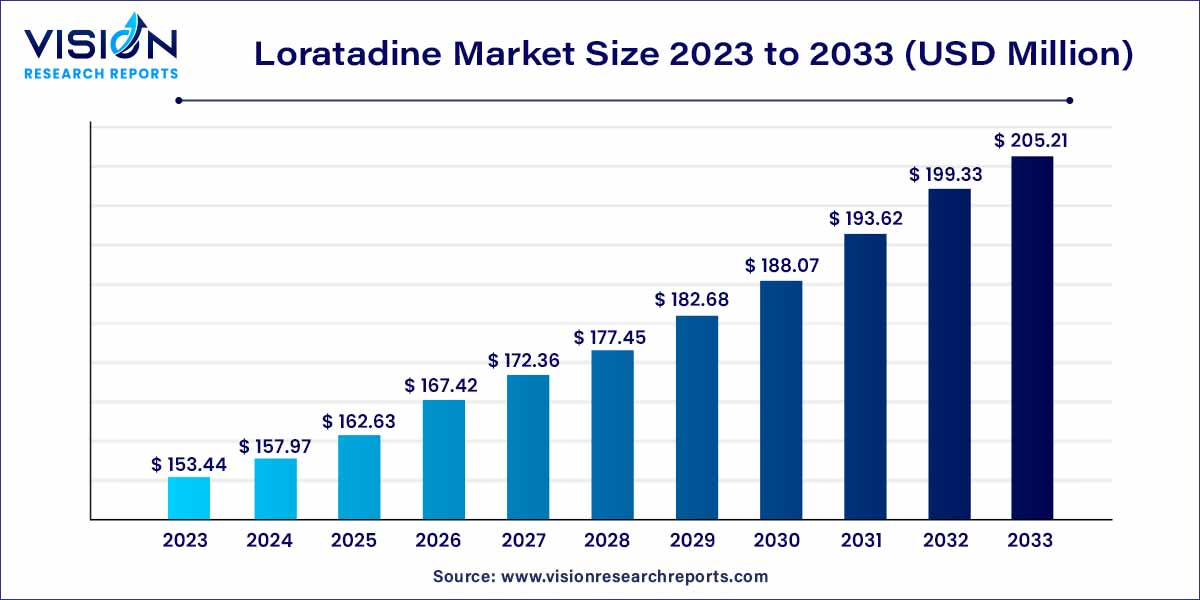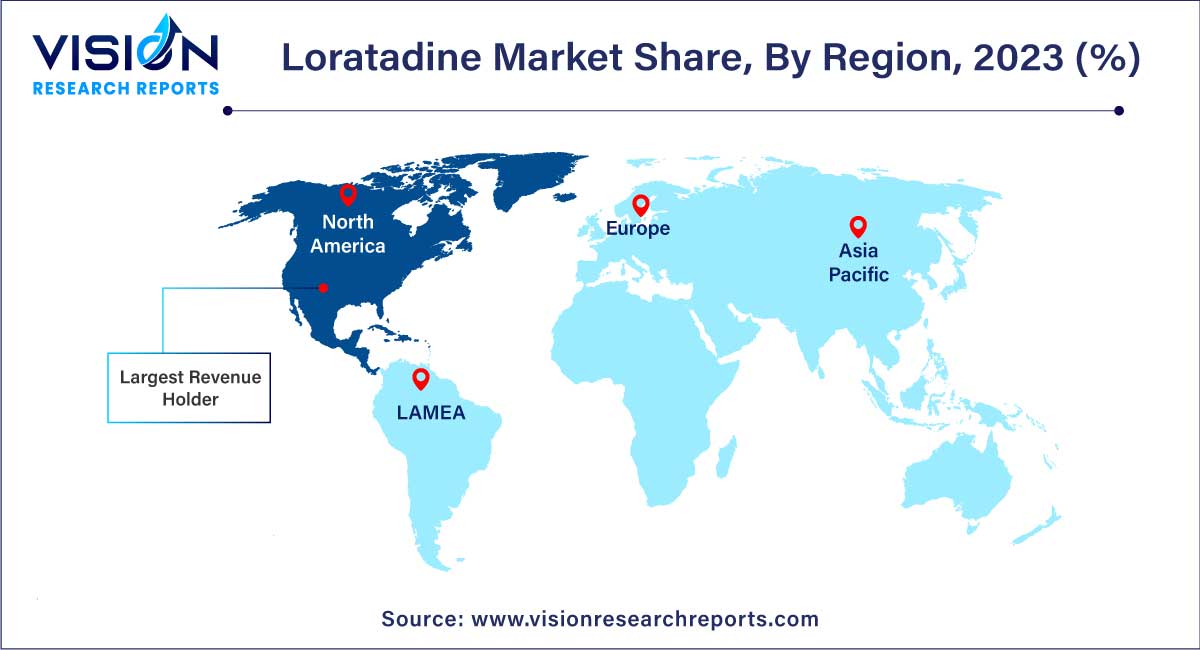The global loratadine market size was estimated at USD 153.44 million in 2023 and it is expected to surpass around USD 205.21 million by 2033, poised to grow at a CAGR of 2.95% from 2024 to 2033. The loratadine market encompasses a comprehensive landscape of pharmaceuticals, driven by factors ranging from consumer demand to regulatory dynamics and technological advancements. Loratadine, a widely used antihistamine medication, is renowned for its effectiveness in alleviating symptoms associated with allergies such as sneezing, itching, and runny nose.

The growth of the loratadine market is propelled by several key factors. Firstly, the increasing prevalence of allergic disorders worldwide, such as allergic rhinitis and urticaria, contributes significantly to the rising demand for antihistamine medications like loratadine. Additionally, the trend towards self-medication and the availability of loratadine as an over-the-counter (OTC) medication further bolster market expansion. Pharmaceutical companies' continuous efforts to innovate and improve loratadine formulations, including advancements in delivery systems and combination therapies, also drive market growth. Moreover, expanding healthcare expenditure, coupled with rising awareness about allergy management, continues to fuel the demand for loratadine, positioning the market for sustained growth in the foreseeable future.
Based on the grade type, the market is segmented into USP Standard Grade, EP Standard Grade, Medicine Standard Grade, and others. The USP standard grade segment held the largest market share in 2023. USP standard grade emphasis on regulatory compliance with established quality and safety regulations, thereby accelerating customer preference and adoption rate.
On the basis of dosage form, the market is segmented into tablets, capsules, syrup, and others. The tablets segment dominated the market in 2023 due to patient convenience, ease of administration, high availability, reliability, and longer shelf life. The strong presence of several industry participants who are manufacturing loratadine tablets in various strengths to cater to a large population base will accelerate the segment growth over the forecast period.
Based on end-use, the loratadine market is segmented into hospital pharmacy, retail pharmacy, and online pharmacy. The online pharmacy segment is expected to grow at the fastest CAGR during the forecast period. Upsurge in the adoption of online platforms owing to large availability and accessibility to diverse product offerings, affordable pricing, and offers driving segmental demand. Moreover, the integration of online pharmacy platforms with telemedicine is expected to provide enormous growth opportunities to the segment.
North America dominated the market share in 2023. The high disease burden and strong presence of several manufacturers are anticipated to propel market growth in this region. Increasing prevalence of seasonal and perennial allergies in the region, accelerating demand for antihistamine medications, including loratadine. The surge in population awareness regarding allergy and consumer preference towards non-drowsy formulations is estimated to spur regional revenue growth potential.

Asia Pacific is predicted to witness the fastest CAGR over the forecast period. Rapidly growing awareness regarding allergic ailments, the rising geriatric population that is highly prone to several allergic conditions, and the increasing prevalence of lifestyle diseases are factors driving the Asia Pacific loratadine market.
By Grade Type
By Dosage Form
By End-use
By Region
Chapter 1. Introduction
1.1. Research Objective
1.2. Scope of the Study
1.3. Definition
Chapter 2. Research Methodology
2.1. Research Approach
2.2. Data Sources
2.3. Assumptions & Limitations
Chapter 3. Executive Summary
3.1. Market Snapshot
Chapter 4. Market Variables and Scope
4.1. Introduction
4.2. Market Classification and Scope
4.3. Industry Value Chain Analysis
4.3.1. Raw Material Procurement Analysis
4.3.2. Sales and Distribution Grade Type Analysis
4.3.3. Downstream Buyer Analysis
Chapter 5. COVID 19 Impact on Loratadine Market
5.1. COVID-19 Landscape: Loratadine Industry Impact
5.2. COVID 19 - Impact Assessment for the Industry
5.3. COVID 19 Impact: Global Major Government Policy
5.4. Market Trends and Opportunities in the COVID-19 Landscape
Chapter 6. Market Dynamics Analysis and Trends
6.1. Market Dynamics
6.1.1. Market Drivers
6.1.2. Market Restraints
6.1.3. Market Opportunities
6.2. Porter’s Five Forces Analysis
6.2.1. Bargaining power of suppliers
6.2.2. Bargaining power of buyers
6.2.3. Threat of substitute
6.2.4. Threat of new entrants
6.2.5. Degree of competition
Chapter 7. Competitive Landscape
7.1.1. Company Market Share/Positioning Analysis
7.1.2. Key Strategies Adopted by Players
7.1.3. Vendor Landscape
7.1.3.1. List of Suppliers
7.1.3.2. List of Buyers
Chapter 8. Global Loratadine Market, By Grade Type
8.1. Loratadine Market, by Grade Type, 2024-2033
8.1.1 USP Standard Grade
8.1.1.1. Market Revenue and Forecast (2021-2033)
8.1.2. EP Standard Grade
8.1.2.1. Market Revenue and Forecast (2021-2033)
8.1.3. Medicine Standard Grade
8.1.3.1. Market Revenue and Forecast (2021-2033)
Chapter 9. Global Loratadine Market, By Dosage Form
9.1. Loratadine Market, by Dosage Form, 2024-2033
9.1.1. Tablets
9.1.1.1. Market Revenue and Forecast (2021-2033)
9.1.2. Capsules
9.1.2.1. Market Revenue and Forecast (2021-2033)
9.1.3. Syrup
9.1.3.1. Market Revenue and Forecast (2021-2033)
9.1.4. Others
9.1.4.1. Market Revenue and Forecast (2021-2033)
Chapter 10. Global Loratadine Market, By End-use
10.1. Loratadine Market, by End-use, 2024-2033
10.1.1. Hospital Pharmacy
10.1.1.1. Market Revenue and Forecast (2021-2033)
10.1.2. Retail Pharmacy
10.1.2.1. Market Revenue and Forecast (2021-2033)
10.1.3. Online Pharmacy
10.1.3.1. Market Revenue and Forecast (2021-2033)
Chapter 11. Global Loratadine Market, Regional Estimates and Trend Forecast
11.1. North America
11.1.1. Market Revenue and Forecast, by Grade Type (2021-2033)
11.1.2. Market Revenue and Forecast, by Dosage Form (2021-2033)
11.1.3. Market Revenue and Forecast, by End-use (2021-2033)
11.1.4. U.S.
11.1.4.1. Market Revenue and Forecast, by Grade Type (2021-2033)
11.1.4.2. Market Revenue and Forecast, by Dosage Form (2021-2033)
11.1.4.3. Market Revenue and Forecast, by End-use (2021-2033)
11.1.5. Rest of North America
11.1.5.1. Market Revenue and Forecast, by Grade Type (2021-2033)
11.1.5.2. Market Revenue and Forecast, by Dosage Form (2021-2033)
11.1.5.3. Market Revenue and Forecast, by End-use (2021-2033)
11.2. Europe
11.2.1. Market Revenue and Forecast, by Grade Type (2021-2033)
11.2.2. Market Revenue and Forecast, by Dosage Form (2021-2033)
11.2.3. Market Revenue and Forecast, by End-use (2021-2033)
11.2.4. UK
11.2.4.1. Market Revenue and Forecast, by Grade Type (2021-2033)
11.2.4.2. Market Revenue and Forecast, by Dosage Form (2021-2033)
11.2.4.3. Market Revenue and Forecast, by End-use (2021-2033)
11.2.5. Germany
11.2.5.1. Market Revenue and Forecast, by Grade Type (2021-2033)
11.2.5.2. Market Revenue and Forecast, by Dosage Form (2021-2033)
11.2.5.3. Market Revenue and Forecast, by End-use (2021-2033)
11.2.6. France
11.2.6.1. Market Revenue and Forecast, by Grade Type (2021-2033)
11.2.6.2. Market Revenue and Forecast, by Dosage Form (2021-2033)
11.2.6.3. Market Revenue and Forecast, by End-use (2021-2033)
11.2.7. Rest of Europe
11.2.7.1. Market Revenue and Forecast, by Grade Type (2021-2033)
11.2.7.2. Market Revenue and Forecast, by Dosage Form (2021-2033)
11.2.7.3. Market Revenue and Forecast, by End-use (2021-2033)
11.3. APAC
11.3.1. Market Revenue and Forecast, by Grade Type (2021-2033)
11.3.2. Market Revenue and Forecast, by Dosage Form (2021-2033)
11.3.3. Market Revenue and Forecast, by End-use (2021-2033)
11.3.4. India
11.3.4.1. Market Revenue and Forecast, by Grade Type (2021-2033)
11.3.4.2. Market Revenue and Forecast, by Dosage Form (2021-2033)
11.3.4.3. Market Revenue and Forecast, by End-use (2021-2033)
11.3.5. China
11.3.5.1. Market Revenue and Forecast, by Grade Type (2021-2033)
11.3.5.2. Market Revenue and Forecast, by Dosage Form (2021-2033)
11.3.5.3. Market Revenue and Forecast, by End-use (2021-2033)
11.3.6. Japan
11.3.6.1. Market Revenue and Forecast, by Grade Type (2021-2033)
11.3.6.2. Market Revenue and Forecast, by Dosage Form (2021-2033)
11.3.6.3. Market Revenue and Forecast, by End-use (2021-2033)
11.3.7. Rest of APAC
11.3.7.1. Market Revenue and Forecast, by Grade Type (2021-2033)
11.3.7.2. Market Revenue and Forecast, by Dosage Form (2021-2033)
11.3.7.3. Market Revenue and Forecast, by End-use (2021-2033)
11.4. MEA
11.4.1. Market Revenue and Forecast, by Grade Type (2021-2033)
11.4.2. Market Revenue and Forecast, by Dosage Form (2021-2033)
11.4.3. Market Revenue and Forecast, by End-use (2021-2033)
11.4.4. GCC
11.4.4.1. Market Revenue and Forecast, by Grade Type (2021-2033)
11.4.4.2. Market Revenue and Forecast, by Dosage Form (2021-2033)
11.4.4.3. Market Revenue and Forecast, by End-use (2021-2033)
11.4.5. North Africa
11.4.5.1. Market Revenue and Forecast, by Grade Type (2021-2033)
11.4.5.2. Market Revenue and Forecast, by Dosage Form (2021-2033)
11.4.5.3. Market Revenue and Forecast, by End-use (2021-2033)
11.4.6. South Africa
11.4.6.1. Market Revenue and Forecast, by Grade Type (2021-2033)
11.4.6.2. Market Revenue and Forecast, by Dosage Form (2021-2033)
11.4.6.3. Market Revenue and Forecast, by End-use (2021-2033)
11.4.7. Rest of MEA
11.4.7.1. Market Revenue and Forecast, by Grade Type (2021-2033)
11.4.7.2. Market Revenue and Forecast, by Dosage Form (2021-2033)
11.4.7.3. Market Revenue and Forecast, by End-use (2021-2033)
11.5. Latin America
11.5.1. Market Revenue and Forecast, by Grade Type (2021-2033)
11.5.2. Market Revenue and Forecast, by Dosage Form (2021-2033)
11.5.3. Market Revenue and Forecast, by End-use (2021-2033)
11.5.4. Brazil
11.5.4.1. Market Revenue and Forecast, by Grade Type (2021-2033)
11.5.4.2. Market Revenue and Forecast, by Dosage Form (2021-2033)
11.5.4.3. Market Revenue and Forecast, by End-use (2021-2033)
11.5.5. Rest of LATAM
11.5.5.1. Market Revenue and Forecast, by Grade Type (2021-2033)
11.5.5.2. Market Revenue and Forecast, by Dosage Form (2021-2033)
11.5.5.3. Market Revenue and Forecast, by End-use (2021-2033)
Chapter 12. Company Profiles
12.1. Merck (U.S.)
12.1.1. Company Overview
12.1.2. Product Offerings
12.1.3. Financial Performance
12.1.4. Recent Initiatives
12.2. Cadila Pharmaceuticals (India).
12.2.1. Company Overview
12.2.2. Product Offerings
12.2.3. Financial Performance
12.2.4. Recent Initiatives
12.3. Morepen (India).
12.3.1. Company Overview
12.3.2. Product Offerings
12.3.3. Financial Performance
12.3.4. Recent Initiatives
12.4. Ultratech India (India).
12.4.1. Company Overview
12.4.2. Product Offerings
12.4.3. Financial Performance
12.4.4. Recent Initiatives
12.5. Vasudha Pharma Chem (India).
12.5.1. Company Overview
12.5.2. Product Offerings
12.5.3. Financial Performance
12.5.4. Recent Initiatives
12.6. Hetero Drugs (India)
12.6.1. Company Overview
12.6.2. Product Offerings
12.6.3. Financial Performance
12.6.4. Recent Initiatives
12.7. Mylan (U.S.).
12.7.1. Company Overview
12.7.2. Product Offerings
12.7.3. Financial Performance
12.7.4. Recent Initiatives
12.8. Changzhou Yabang (China)
12.8.1. Company Overview
12.8.2. Product Offerings
12.8.3. Financial Performance
12.8.4. Recent Initiatives
12.9. Shaanxi Hanjiang (China).
12.9.1. Company Overview
12.9.2. Product Offerings
12.9.3. Financial Performance
12.9.4. Recent Initiatives
12.10. Inke, S.A. (Spain)
12.10.1. Company Overview
12.10.2. Product Offerings
12.10.3. Financial Performance
12.10.4. Recent Initiatives
Chapter 13. Research Methodology
13.1. Primary Research
13.2. Secondary Research
13.3. Assumptions
Chapter 14. Appendix
14.1. About Us
14.2. Glossary of Terms
 Cross-segment Market Size and Analysis for
Mentioned Segments
Cross-segment Market Size and Analysis for
Mentioned Segments
 Additional Company Profiles (Upto 5 With No Cost)
Additional Company Profiles (Upto 5 With No Cost)
 Additional Countries (Apart From Mentioned Countries)
Additional Countries (Apart From Mentioned Countries)
 Country/Region-specific Report
Country/Region-specific Report
 Go To Market Strategy
Go To Market Strategy
 Region Specific Market Dynamics
Region Specific Market Dynamics Region Level Market Share
Region Level Market Share Import Export Analysis
Import Export Analysis Production Analysis
Production Analysis Others
Others